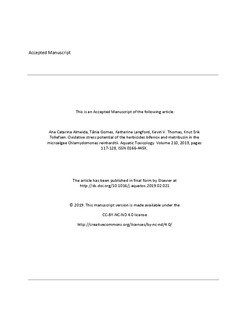| dc.contributor.author | Almeida, Ana Catarina | |
| dc.contributor.author | Gomes, Tania | |
| dc.contributor.author | Langford, Katherine | |
| dc.contributor.author | Thomas, Kevin V | |
| dc.contributor.author | Tollefsen, Knut-Erik | |
| dc.date.accessioned | 2019-11-20T10:04:39Z | |
| dc.date.available | 2019-11-20T10:04:39Z | |
| dc.date.created | 2019-06-14T08:31:22Z | |
| dc.date.issued | 2019 | |
| dc.identifier.citation | Aquatic Toxicology. 2019, 210 117-128. | |
| dc.identifier.issn | 0166-445X | |
| dc.identifier.uri | http://hdl.handle.net/11250/2629452 | |
| dc.description.abstract | The widespread presence of herbicides in the aquatic environment has raised awareness about the need to develop further in depth ecotoxicological risk assessments, more specifically on potential effects on photosynthetic organisms as microalgae. The majority of the information available regarding the toxicity of herbicides towards microalgae is related to traditional toxicological and regulatory-relevant endpoints such as growth inhibition, leaving a significant gap on knowledge regarding underlying interactions and damage to biological targets. In this context, this study aimed to supplement the general toxicity information of bifenox and metribuzin in the microalgae Chlamydomonas reinhardtii using a battery of selected high-throughput methods. This multiple-endpoint approach included the measurement of formation of reactive oxygen species (ROS), alterations in reduced glutathione (GSH) content, formation of lipid peroxidation (LPO), photosystem II (PSII) performance and loss of photosynthetic pigments after 24 h exposure. Results obtained showed that both herbicides caused a concentration-dependent increase in ROS formation, with bifenox showing higher but less reactive ROS. This increase in ROS production by bifenox and metribuzin was followed by alterations in the antioxidant capacity of algae, oxidative damage in the form of LPO and alterations in pigment content. Furthermore, both herbicides impacted the photosynthetic activity of algae, as seen by alterations in the maximum and effective quantum efficiency of PSII, PSII photochemistry and energy dissipation pathways, impact in the water-splitting apparatus and reduction in the electron transport rate. The inhibitory effect of metribuzin on photosynthetic processes/components was larger than that seen for bifenox. The impact of bifenox and metribuzin in the photosynthetic processes of C. reinhardtii seems to be in close association with the formation of ROS and consequent oxidative stress and damage in algal cells. Overall, this study showed that the high-throughput methods developed could successfully characterise both potential Modes of Action and adverse effects of bifenox and metribuzin in C. reinhardtii. | |
| dc.language.iso | eng | |
| dc.title | Oxidative stress potential of the herbicides bifenox and metribuzin in the microalgae Chlamydomonas reinhardtii | |
| dc.title.alternative | Oxidative stress potential of the herbicides bifenox and metribuzin in the microalgae Chlamydomonas reinhardtii | |
| dc.type | Peer reviewed | |
| dc.type | Journal article | |
| dc.description.version | acceptedVersion | |
| dc.subject.nsi | VDP::Økotoksikologi: 489 | |
| dc.subject.nsi | VDP::Eco-toxicology: 489 | |
| dc.source.pagenumber | 117-128 | |
| dc.source.volume | 210 | |
| dc.source.journal | Aquatic Toxicology | |
| dc.identifier.doi | 10.1016/j.aquatox.2019.02.021 | |
| dc.identifier.cristin | 1704820 | |
| dc.relation.project | EC/FP7/290100 | |
| dc.relation.project | Norges forskningsråd: 223268 | |
| cristin.unitcode | 192,14,0,0 | |
| cristin.unitname | Miljøvitenskap og naturforvaltning | |
| cristin.ispublished | true | |
| cristin.fulltext | postprint | |
| cristin.qualitycode | 2 | |
| dc.date.embargoenddate | 2023-05-01 | |
